Is 102.6 a high fever. When Is a Fever Too High for Children? Understanding Fever Thresholds and Warning Signs
What temperature is considered a fever in children. How to accurately measure a child’s temperature. When should you seek medical attention for a child’s fever. What are the signs of a serious fever in infants, toddlers, and older children.
Understanding Fever: What Constitutes an Elevated Body Temperature?
Fever is a common occurrence in childhood, often causing concern for parents. But what exactly is considered a fever? A fever is defined as any body temperature that reaches 100.4°F (38°C) or above. Normal body temperature typically hovers around 98.6°F (37°C), though it may fluctuate slightly throughout the day.
Fevers are generally categorized into two types:
- Low-grade fever: Temperature between 100.4°F (38°C) and 102.2°F (39°C)
- High fever: Temperature above 102.2°F (39°C)
It’s important to note that a fever itself is not an illness, but rather a sign that the body’s immune system is actively fighting an infection or illness.

Recognizing Fever Symptoms in Children: Beyond the Thermometer
While an elevated temperature is the primary indicator of a fever, children may experience additional symptoms. These can include:
- Chills and shivering
- Excessive sweating
- Muscle aches and general discomfort
- Changes in appetite
- Signs of dehydration
- Weakness or fatigue
- Behavioral changes
Is the temperature reading the only factor to consider when assessing a child’s fever? No, it’s crucial to take into account several other factors, including:
- The child’s age
- Their overall behavior and responsiveness
- The duration of the fever
- Any accompanying symptoms
Fever in Infants: When to Be Concerned
For newborns and young infants, even a slight temperature elevation can be a cause for concern. Parents should contact a healthcare provider or seek urgent care if their baby has a fever of 100.4°F (38°C) or above, or a temperature below 97.7°F (36.5°C) when taken rectally.
What are the warning signs that require immediate medical attention for infants with fever?

- Difficulty feeding or refusing to eat
- Labored breathing or respiratory distress
- Unexplained rashes
- Vomiting or diarrhea
- Unusual lethargy or inconsolable crying
How should you measure an infant’s temperature for the most accurate reading? The most reliable method for infants is using a digital thermometer inserted rectally. Some research suggests that temporal artery thermometers can also provide accurate readings for this age group, but it’s best to consult with your pediatrician for specific guidelines.
Toddlers and Fever: Guidelines for Parents
For older babies and toddlers, parents should contact a doctor if the child’s fever reaches 102.2°F (39°C) or higher. It’s also important to monitor how the child responds to over-the-counter (OTC) fever reducers, such as ibuprofen or acetaminophen.
When should you seek urgent care for a toddler with a fever?
- If the fever doesn’t respond to OTC medications
- Difficulty waking or excessive sleepiness
- Signs of respiratory distress
- Decreased urine output
- Inability to keep fluids down due to vomiting
- Presence of an unexplained dark rash
- Complaints of a stiff neck or severe abdominal pain
What are the most accurate methods for measuring a toddler’s temperature? While rectal readings are still considered the most precise, parents may also use digital thermometers in the underarm or temporal artery scanners. In-ear thermometers can be used for children aged 6 months and older.

Fever in Older Children: When to Take Action
For children over 3 years old, a fever above 102°F (38.9°C) that persists for more than two days may warrant medical attention. If the fever continues for five or more days, or doesn’t respond to OTC fever reducers, it’s important to consult a healthcare provider.
What symptoms, in combination with fever, should prompt urgent care for older children?
- Difficulty breathing or swallowing
- Persistent vomiting or inability to keep fluids down
- Pain or burning sensation during urination
- Infrequent urination
- Presence of an unexplained dark rash
- Complaints of neck stiffness or severe abdominal pain
- Extreme lethargy or difficulty waking
How can you accurately measure the temperature of children aged 4 and up? For this age group, parents can use digital thermometers to take oral temperatures under the tongue. Other options include ear thermometers, armpit readings, or temporal artery scanners.
Febrile Seizures: Understanding This Rare Fever Complication
Febrile seizures are a rare but concerning complication that can occur in some children with fever, typically between the ages of 6 months and 5 years. These seizures may manifest as jerking movements or a brief loss of consciousness.

What should parents do if their child experiences a febrile seizure? If a seizure occurs, it’s important to contact a healthcare provider immediately. If the seizure lasts longer than 5 minutes, emergency services should be called.
Are febrile seizures dangerous? While frightening for parents, most febrile seizures are short-lived and do not cause long-term harm. However, medical evaluation is always recommended to rule out more serious conditions.
Fever Management: Tips for Caring for a Feverish Child
While fever can be concerning, it’s often a sign that the body is effectively fighting off an infection. Here are some tips for managing fever in children:
- Ensure adequate hydration by offering plenty of fluids
- Dress the child in lightweight, breathable clothing
- Keep the room temperature comfortable, avoiding overheating
- Use OTC fever reducers as directed by a healthcare provider
- Monitor the child’s overall behavior and other symptoms
- Rest is crucial for recovery, so encourage plenty of sleep
Is it necessary to treat every fever with medication? Not always. Low-grade fevers often don’t require treatment if the child is comfortable and well-hydrated. However, medication may help reduce discomfort and improve sleep.

Trusting Parental Instincts: When to Seek Medical Advice
Parents often have an intuitive sense when something isn’t right with their child. If you have concerns about your child’s fever or overall health, it’s always appropriate to reach out to your pediatrician’s office for guidance.
Should you feel hesitant about contacting your child’s doctor for fever-related concerns? Absolutely not. Healthcare providers understand that parents may have questions and would rather err on the side of caution when it comes to children’s health.
What information should you have ready when calling the doctor about your child’s fever?
- The child’s exact temperature and method used to measure it
- How long the fever has persisted
- Any other symptoms the child is experiencing
- Details about any medications given and the child’s response
- Information about recent exposures to illnesses or infections
By staying informed about fever thresholds, recognizing warning signs, and knowing when to seek medical attention, parents can navigate their child’s fevers with greater confidence. Remember, while fevers can be worrisome, they are often a sign that the body is working hard to fight off infections and restore health.

When Is a Fever Too High for a Child, Toddler, or Newborn?
Your little one feels warm to the touch. After taking their temperature, you realize it’s 103°F — a fever!
Even if this scenario sounds super familiar, it can still catch you off guard. Before you race to the doctor, though, take a deep breath.
It’s helpful to familiarize yourself with fever, its function in the human body, and any warning signs that may mean it’s serious — or, alternatively, when you can relax.
Related: What you should do if your newborn has a cold
Normal body temperature is around 98.6°F, though it may fluctuate slightly higher or lower throughout the day. A fever starts with any temperature that reaches 100.4°F or above.
A temperature between 100.4°F and 102.2°F is considered a low-grade fever; a temperature above 102.2°F is considered a high fever.
A fever isn’t a sickness in itself. Instead, elevated body temperature is a sign that your child’s immune system is hard at work fighting off some type of invader — usually an illness or infection.
Along with an elevated temperature, your child may experience these fever symptoms:
- chills
- sweating
- muscle aches
- appetite changes
- dehydration
- weakness
- changes in behavior
The number on the thermometer isn’t always the best indicator of how sick your child is. You need to take into account:
- your child’s age
- how they’re acting
- the number of days they’ve had the fever
- any other symptoms you observe
For example, a small percentage of younger kids — usually between the ages of 6 months and 5 years, according to Mayo Clinic — may even experience febrile seizures. These seizures may involve jerking motions or look like your child is passing out.
Call your doctor if your child experiences a seizure or call 911 if the seizure lasts longer than 5 minutes.
In young babies, even slight temperatures may be a reason for concern. That’s why you should always contact your doctor or head to urgent care if your little one has any fever that’s 100. 4°F or above. (The same goes with a temperature lower than 97.7°F when taken rectally.)
4°F or above. (The same goes with a temperature lower than 97.7°F when taken rectally.)
You should also head to the ER if your baby has a fever and any of the following symptoms:
- trouble feeding
- trouble breathing
- unexplained rash
- vomiting or diarrhea
- acting differently (lethargic, inconsolable, etc.)
For the most accurate read, take your infant’s temperature with a digital thermometer inserted rectally (yes, that’s the best way). There’s some research to suggest that temporal artery thermometers can work accurately for this age as well, but speak with your doctor for guidelines.
Related: Baby fever 101: How to care for your child
In older babies and toddlers, call your doctor if your child’s fever is 102.2°F or above.
You’ll also want to pay attention to how your child responds to over-the-counter (OTC) medications. Always ask your pediatrician about giving any OTC drugs to babies under age 1.
If the fever doesn’t respond to fever reducers (ibuprofen, acetaminophen), there may be something more serious going on.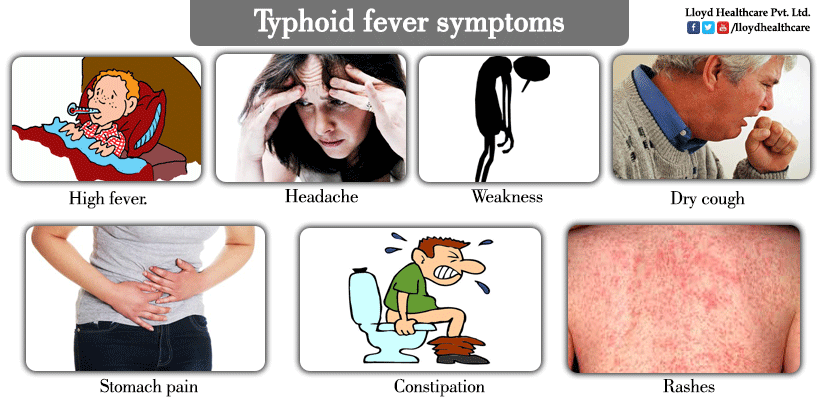
Other symptoms that warrant urgent care:
- trouble waking up
- trouble breathing
- decreased urine output
- difficulty keeping fluids down (vomiting)
- unexplained dark rash
- stiff neck, abdominal pain, or other concerns
Rectal reading may still be the best way to get an accurate temperature with older babies and toddlers. That said, you may also have success using a digital thermometer in the underarm or a temporal artery scanner.
If you have an in-ear thermometer, you’ll want to wait until your child is at least 6 months old to use it.
Related: Symptoms of fever in adults, children, and babies
For kids over age 3, a fever over 102° F that lasts for 2 or more days may be a reason for concern.
If their doctor tells you to keep an eye on it, a couple days may be OK.
However, if your little one has had a fever for 5 or more days, be sure to call back to make an appointment with their doctor. The same goes for a fever that doesn’t lower with OTC medications.
Other symptoms that may warrant urgent care:
- trouble breathing or swallowing
- difficulty keeping fluids down (vomiting)
- burning with urination or infrequent urination
- unexplained dark rash
- stiff neck, abdominal pain, or other concerns
- acting lethargic or difficult to wake
For children ages 4 and up, you may use a digital thermometer to take temperature orally under the tongue (if your child can hold it there long enough). For best results, be sure to wait 30 minutes after your child last ate or drank anything.
You may also take a reading in the ear or armpit — or even on the forehead using a temporal artery thermometer.
You know your child best. If you feel in your gut something is wrong, don’t hesitate to give your pediatrician’s office a call. And don’t feel silly — they get questions all the time and would rather you be extra safe when it comes to your child’s health.
Get in touch with your doctor or urgent care if:
- Your baby is younger than 3 months old with a fever over 100.
 4°F.
4°F. - Your baby (ages 3 to 6 months) has a temperature of 102°F and is acting unlike themselves (lethargic, uncomfortable, etc.).
- Your older baby (ages 6 to 24 months) has a temperature over 102°F that lasts more than 1 day with no other signs of illness, like cough or diarrhea.
- Your child’s fever has been present for 5 days or longer.
- Your little one’s fever is 104°F or above, regardless of the presence of other symptoms.
- Your child’s fever doesn’t lower even when taking fever reducers.
- Your child is inconsolable, lethargic, or not acting like themselves.
- Your little one is showing signs of dehydration, like decreased urine output. (FYI: Babies should wet at least 4 diapers per day; older kids should urinate at least once every 8 to 12 hours.)
- Your child has recently had immunizations and has a fever of 102° F or higher.
- Your child has recently had immunizations and has had an elevated temperature for more than 48 hours.

- Your child has a febrile seizure. Call your doctor if it lasts less than 5 minutes. If longer, call 911.
Remember: You should always call your doctor for fever in babies under 3 months old.
Older kids do get fevers, though. So while it’s important to know when you should head to the doctor, it’s equally key to know when you can relax and monitor on your own.
In many cases, a fever is their body’s response to fighting off a mild illness. It will resolve on its own when the illness winds down and your child gets better.
You may be able to monitor at home if:
- A fever lasts fewer than 3 to 5 days, provided your little one is acting like themselves. Observe their eating, drinking, and play patterns to see if they’re at their normal level of activity. Being slightly more tired than usual is expected, though.
- The fever is below 102.5°F in children ages 3 months to 3 years or below 103°F in older kids. (Of course, this is provided there are no other warning signs.
 ) Temperatures in this range are common and don’t necessarily signal an emergency.
) Temperatures in this range are common and don’t necessarily signal an emergency. - Your child gets a low-grade fever following immunizations. A slight temperature in the first couple of days after shots isn’t necessarily a reason for concern.
Related: What are the flu symptoms in kids and how is it treated?
Chances are, your little one will have many fevers in their lifetime.
Pay attention to the number on the thermometer but also look at your child. If they’re acting normally and drinking enough fluids — and their fever goes away relatively quickly — you can relax and try at-home comfort measures, like giving them a lukewarm bath.
Otherwise, get in touch with your doctor or head to urgent care to get things checked out.
Symptoms, treatment, and when to seek help
A fever is a part of the body’s protective response to illness. When certain pathogens, such as bacteria and viruses, enter the body, the immune system signals the body to increase its temperature in an attempt to destroy them.
However, severe illness can cause the mechanisms that maintain a normal body temperature to go awry, and the results can lead to extremely high temperatures that can be life-threatening.
This article will discuss how a fever affects an adult’s body and when it is cause for concern.
If a person is concerned about a fever or how they feel overall, they should talk to a doctor.
Share on PinterestDoctors consider a temperature above 104°F (40°C) to be a high-grade fever.
As a general rule, adults should consider seeking medical attention if their temperature reaches above 104 °F (40°C). Doctors consider this temperature to be a high-grade fever.
However, a fever is not the only symptom a person has when they are ill. A person should consider other symptoms, such as vomiting, breathing issues, confusion, or how they feel overall when deciding whether they need medical attention.
Doctors categorize a fever by the reading on the thermometer, how long the fever lasts, and whether it keeps going up and down.
Normal body temperature can fluctuate. According to a 2019 systematic review, typical body temperatures vary according to a person’s age, and whether they take their temperature orally or rectally. The table below indicates a range of normal body temperatures.
| Ages | Oral °F (°C) | Rectal °F (°C) |
| Mean temperature | 97.8 (36.5) | 98.6 (37.0) |
| Less than 60 years of age | 98.1 (36.7) | 98.8 (37.1) |
| Over 60 years of age | 97.5 (36.4) | 98.6 (37.0) |
It is important to note that temperatures can fluctuate. A normal rectal body temperature ranges from 98.6–100.4°F.
The following are the classifications of body temperature ranges, according to an article in the Journal of Infection and Public Health:
- Mild or low-grade fever: 100.4–102.2°F (38–39°C)
- Moderate grade fever: 102.
 2–104.0°F (39°C–40°C)
2–104.0°F (39°C–40°C) - High-grade fever: 104.1–106.0°F (40°C–41.1°C)
These temperature values are rectal measurements, which doctors consider the most accurate.
However, the article also emphasizes that doctors can better diagnose a person’s condition by considering their other symptoms rather than the severity of their temperature.
Sustained or continuous fever
A sustained fever is when a person has a temperature above normal that does not fluctuate by more than 1.5°F (1°C) for 24 hours.
Causes may include:
- Gram-negative bacteria: These are bacteria that can cause pneumonia, bloodstream infections, and surgical site infections.
- Typhoid: Typhoid is a bacterial infection that can cause fever.
- Acute bacterial meningitis: This is a severe infection that requires emergency medical help.
- Urinary tract infection (UTI): Cystitis is an infection of the bladder, and urethritis is an infection of the urethra.

Intermittent fever
An intermittent fever occurs when a person experiences a raised temperature for several hours a day. The temperature then goes back to normal before spiking again.
Common causes may include:
- Malaria: This is an infection that some mosquitoes transmit.
- Tuberculosis (TB): This is an infection of the lungs.
- Lymphoma: This is a form of cancer that begins in the cells.
- Sepsis: This occurs when the body has an extreme reaction to an infection.
Remittent fever
This is a daily fever that is always higher than normal but may fluctuate as much as 3.6°F (2°C) throughout the day.
Common causes may include:
- Infective endocarditis: This is an infection of the endocardium, which is the membrane that lines the inside of the heart.
- Rickettsiae infections: This is an infection transmitted by ticks, mites, and lice.

People who experience an internal temperature of 104°F (40°C) and higher for prolonged periods can develop hyperthermia. For this reason, it is essential to try to keep a fever from becoming too high.
Potential complications from a high-grade fever can include:
- seizures
- unsteadiness
- unconsciousness
- lethargy
- coma
A high-grade fever can also cause cognitive dysfunction, which affects a person’s memory, comprehension, reasoning, and problem-solving ability. Some people may also have difficulty paying attention.
Typically, these symptoms are only temporary, and most people recover. However, in extreme circumstances, some people experience permanent changes.
Fever is a common symptom of the novel coronavirus, known as COVID-19.
According to a study published in the New England Journal of Medicine in February 2020, data on 1,099 people in China who had COVID-19 showed that 43.8% had a fever on admission to the hospital. An estimated 88.7% developed a fever during their hospitalization.
An estimated 88.7% developed a fever during their hospitalization.
The authors defined a fever as an axillary (armpit) temperature of 99.8°F (37.7°C) or higher.
Other symptoms include:
- a cough
- shortness of breath
- nausea
- vomiting
- diarrhea
If a person suspects they may have COVID-19, they should call a doctor or health department for further testing.
For live updates on the latest developments regarding the novel coronavirus and COVID-19, click here.
A low-grade fever can be the body’s protective measure. Scientists are still in debate whether a person should treat a low-grade fever.
However, if a person does have a fever or does not feel well, they could take fever-reducing medications, such as:
- acetaminophen
- ibuprofen
- aspirin
As a fever is typically a symptom of another condition, a person may require different treatments depending on the cause.
If a person has an underlying bacterial illness, a doctor may prescribe antibiotics. These can treat the infection, which can help reduce fever.
Other steps a person can take to make themselves more comfortable include resting, drinking plenty of fluids, wearing loose clothing, and taking cool or lukewarm baths.
There are some steps a person can take to help prevent getting a fever:
- Always cover the mouth and nose when sneezing and wash hands immediately after sneezing or coughing.
- Refrain from sharing personal items, such as utensils, cups, and even toothbrushes.
- Try not to touch the face. A person can easily transmit the pathogen from their face to their nose or mouth, which might allow the germs to enter the body.
- Avoid contact with people who are sick. This can help prevent the transmission of illness.
- Maintain good hygiene. Washing hands may help prevent bacteria and viruses from spreading.
Learn more about washing hands properly here.
A fever is a protective mechanism for the body as the immune system works to fight against illness in a variety of ways.
If a person feels very unwell in addition to having a fever or they are already immunocompromised due to pre-existing conditions, they should seek medical attention.
A person should also see their doctor if they have tried to control their fever at home, but over-the-counter medicines and other treatments are ineffective.
A fever can become dangerous if it reaches 104°F (40°C) or higher.
At what temperature to call an ambulance for a child and an adult – September 17, 2022
Sometimes calling an ambulance is not necessary – just drink paracetamol
Photo: Elena Latypova / NGS55.RU
Share
this time alarm the doctor, while others are ready to call an ambulance as soon as the thermometer shows 37.5. Doctors don’t always help either: someone asks why they called, someone asks why they didn’t call earlier? We talked with doctors to put an end to this issue: at what temperature should you call an ambulance, when to call a doctor, and in which case just drink an antipyretic and not disturb anyone.
In fact, there is no bar by which you can say: if the temperature is 0.1 degrees higher, it’s time to call an ambulance. Other symptoms may also be decisive.
– An ambulance is called when the temperature is febrile – that is, above 38.5 and is not dropping well, – says infectious disease doctor Andrey Pozdnyakov. – An ambulance is called when the temperature is accompanied by some other symptoms similar to life-threatening ones. The most striking is convulsions, impaired consciousness, severe tachycardia. An ambulance should be called according to the totality of symptoms, the temperature is not necessarily one of them.
Andrey Pozdnyakov — infectious disease specialist, candidate of medical sciences, chief physician of the clinical diagnostic laboratory “Invitro-Siberia”.
An adult needs an ambulance for hyperthermic reactions, that is, a very high temperature.
“If the temperature is above 40, then an ambulance is definitely needed, because it is fraught with serious consequences,” says therapist Ivan Skorokhodov. – If the temperature persists for a long time. If you have covid or you suspect that it is him, then if there are risk factors, a fever for more than three days is a reason to call an ambulance. If, in addition to temperature, you have abdominal pain, frequent loose stools is a suspicion of an intestinal infection, if the pain is intense, this may be a surgical pathology.
– If the temperature persists for a long time. If you have covid or you suspect that it is him, then if there are risk factors, a fever for more than three days is a reason to call an ambulance. If, in addition to temperature, you have abdominal pain, frequent loose stools is a suspicion of an intestinal infection, if the pain is intense, this may be a surgical pathology.
Ivan Skorokhodov — practicing therapist, allergist-immunologist. Member of the Russian Association of Allergists and Immunologists.
For children, the rules are slightly different: a temperature above 39 in a child is already a risk of seizures. With an acute appearance of temperature in a child, an ambulance is called in any case.
The polyclinic always has a doctor on duty who sees patients. You can turn to him if you feel unwell, but there is no reason to call an ambulance. However, with a temperature, it is still not worth going to the clinic.
— Let’s be honest and correct: from the point of view of epidemiology, it does not matter what disease caused the fever – covid, not covid, most often it is an acute respiratory infection. Accordingly, in order not to infect others, in principle, you don’t need to go to the clinic,” says Andrey Pozdnyakov. – If it is clear that this is a respiratory infection and the person is an adult, without any risk groups, then try to lower the temperature yourself and call a doctor as planned. In any case, you do not need to go to the clinic at a temperature.
Accordingly, in order not to infect others, in principle, you don’t need to go to the clinic,” says Andrey Pozdnyakov. – If it is clear that this is a respiratory infection and the person is an adult, without any risk groups, then try to lower the temperature yourself and call a doctor as planned. In any case, you do not need to go to the clinic at a temperature.
As you might have guessed from the previous point, whenever you have a fever. If you do not notice anything unusual in your condition, you can try to cope on your own – antipyretic, vasoconstrictor drops, lozenges or tablets for sore throat. It is worth taking an antipyretic at a temperature above 38.5 degrees, but if the temperature is lower, and you still feel unwell, it is not necessary to endure the malaise.
– Temperature is just a symptom of the immune system and the development of inflammation. Some people do not tolerate inflammation well, they have a so-called flu-like syndrome: weakness, malaise, aches, pain in the joints, muscles, headaches, eyes hurt and fever, says Ivan Skorokhodov. – In fact, this is the response of the body to the introduction of an infection, for some it is more, for others it is less. The drugs we take when we have a temperature block this excess inflammation and we feel better accordingly.
– In fact, this is the response of the body to the introduction of an infection, for some it is more, for others it is less. The drugs we take when we have a temperature block this excess inflammation and we feel better accordingly.
The doctor emphasizes that if you see that the temperature does not go away, symptomatic therapy with over-the-counter drugs does not help for three days – this also requires a doctor’s call.
If you cannot stay at home with a fever, call your doctor to take sick leave. During a pandemic, all patients with symptoms of SARS are considered suspicious for covid, so it’s better to play it safe and not cough on others. How sick leave is now issued for covid and colds, we talked about in this material, and here you can read about how it is paid.
What is the normal body temperature? What if it’s too high? What if it’s too low? — Meduza
1
What happened?
Fever is the most common symptom of the new coronavirus infection. It occurs in 90% of cases. True, it may appear with the development of the disease, and not at its very beginning.
It occurs in 90% of cases. True, it may appear with the development of the disease, and not at its very beginning.
Because of this, people began to take their temperature more often, and it turned out that it was rarely 36.6 °C. This has become a cause for concern.
2
So everyone has a problem? Or is 36.6 not ideal?
Of course, 36.6°C is not ideal. This is the average temperature of healthy people, measured in the mouth. In one study, the range of normal values was from 35.3 to 37.7 °C, in the other – even more. The temperature measured in the ear and temple was below 36.6 °C by hundredths of a degree, under the arm was lower by an average of 0.26 °C, that is, it was approximately 36.3 °C. Data on average normal rectal temperature is less, but what is available speaks of 36.9°C
In addition, during the day in a healthy person, the temperature can change by half a degree. Also, it is not the same depending on the season, age (in older people it is lower), on the phase of the menstrual cycle, on whether the person ate before the measurement (the temperature rises after eating), and other factors.
3
But do they somehow determine the elevated temperature?
Yes, and this is very conditional. Medical specialists need to make difficult decisions, often quite quickly – and it is obvious that it is impossible to determine in advance the normal temperature of a particular person, and then, focusing on these indicators, say whether it is elevated right now. Therefore, the average value is used. For example, the World Health Organization encourages people to stay at home even with mild symptoms and 37.3 ° C (without specifying the place of measurement). But she suggests that medical workers in an epidemic should pay attention to a fever of 38 ° C and above.
The US Centers for Disease Control and Prevention, regardless of the new coronavirus infection, defines a fever as 38 ° C or higher (also without specifying the place of measurement). At the same time, if the temperature cannot be measured or the person has already taken antipyretics, it is allowed to focus on the patient’s feelings: if he feels that the temperature is elevated, then, apparently, it is.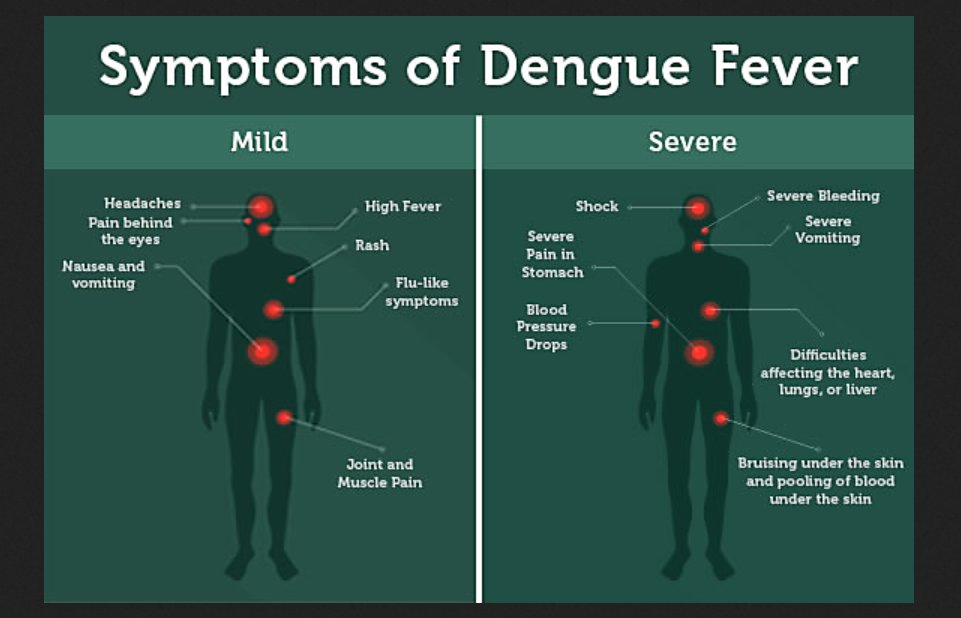
It is known, however, that neonates, older people, patients with chronic renal failure, and those taking corticosteroids may not have a fever when other people do.
4
What does fever even mean? That there is some kind of infection?
This too. But it can also be in a condition called “hyperthermia”. The difference is that when it is hot, the human body begins to consider the elevated temperature as normal and actively maintains it. With hyperthermia, the body does not cease to consider the normal temperature as normal, but at the same time, for various reasons, it heats up. For example, due to too warm clothes, training in a hot room, hyperthyroidism, ecstasy use. Such a condition cannot be fought with ordinary antipyretics – physical methods work here, like a bath with cool (not cold) water.
It is impossible to separate hyperthermia from fever in any universal way – usually doctors rely on other symptoms and concomitant factors. For example, if a person was brought to the hospital in August from a sports ground, then hyperthermia is more likely to be suspected. If a person is hot, but does not sweat, this is also evidence in her favor. As well as the situation when ordinary antipyretics do not help.
If a person is hot, but does not sweat, this is also evidence in her favor. As well as the situation when ordinary antipyretics do not help.
5
Is it normal if the temperature is low? Can it even be too low?
The temperature is too low – this is on average below 35 °C. The most obvious cause of this condition is frost outside or low temperature indoors. But hypothermia (a condition in which the temperature is lowered) can also occur in other cases. For example, for:
- hypothyroidism
- head injury
- stroke
- hypoglycemia (low blood sugar; occurs, for example, with diabetes mellitus)
- anorexia nervosa
- lack of physical activity
- alcohol poisoning
90 085 certain medications (such as beta-blockers)
In this case, a person may shake or, conversely, he may be very lethargic. He may experience confusion, loss of memory, he will speak with difficulty, breathe more often.
6
How to measure temperature correctly?
The most accurate temperature measurement available at home is rectal (in the rectum). But the big question is whether such measurement accuracy is needed, if it is so inconvenient.
If you decide to measure the temperature in your mouth, then you can do this only 20-30 minutes after you smoked, ate something or drank something hot or cold. The tip of the thermometer should be placed under the tongue. You need to breathe through your nose.
Rectal measurements The American Academy of Pediatrics recommends for children under three years of age because they are unlikely to keep a thermometer in their mouth properly. To do this, you need to grease the tip of the thermometer with something like Vaseline, put the child on your stomach on your knees or lay him on his back and bend his legs, and then insert the thermometer 1–2.5 centimeters.
Underarm measurements are often inaccurate because people don’t hold their arm tightly.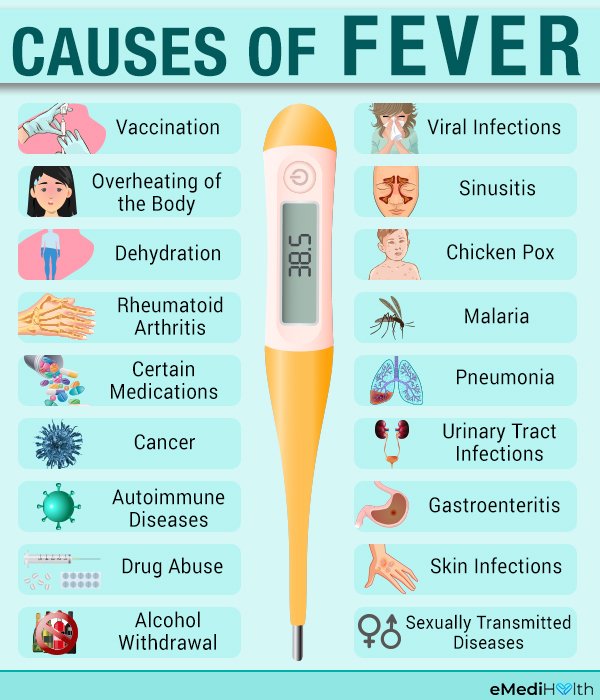 However, in the UK, this is how it is recommended to measure the temperature of children under five years old (and dissuade from rectal measurements).
However, in the UK, this is how it is recommended to measure the temperature of children under five years old (and dissuade from rectal measurements).
The thermometer should always be washed with soap and warm water before use or wiped with alcohol. Each place should have its own thermometer: you cannot use the same one for rectal and axillary measurements.
7
Which thermometer should I choose?
Not mercury. They may be more accurate than others, but the risks outweigh the benefits. All over the world they are getting rid of them.
The question is very complicated, because there are no official centralized collection points for mercury thermometers. In some regions, there are private companies and municipal enterprises that accept mercury thermometers.
Doctors usually recommend the use of electronic thermometers. If you have one, it’s a good idea to look at the manual. There, for example, you can find information that it is better to hold the thermometer for some more time after the beep, so that the result is more accurate.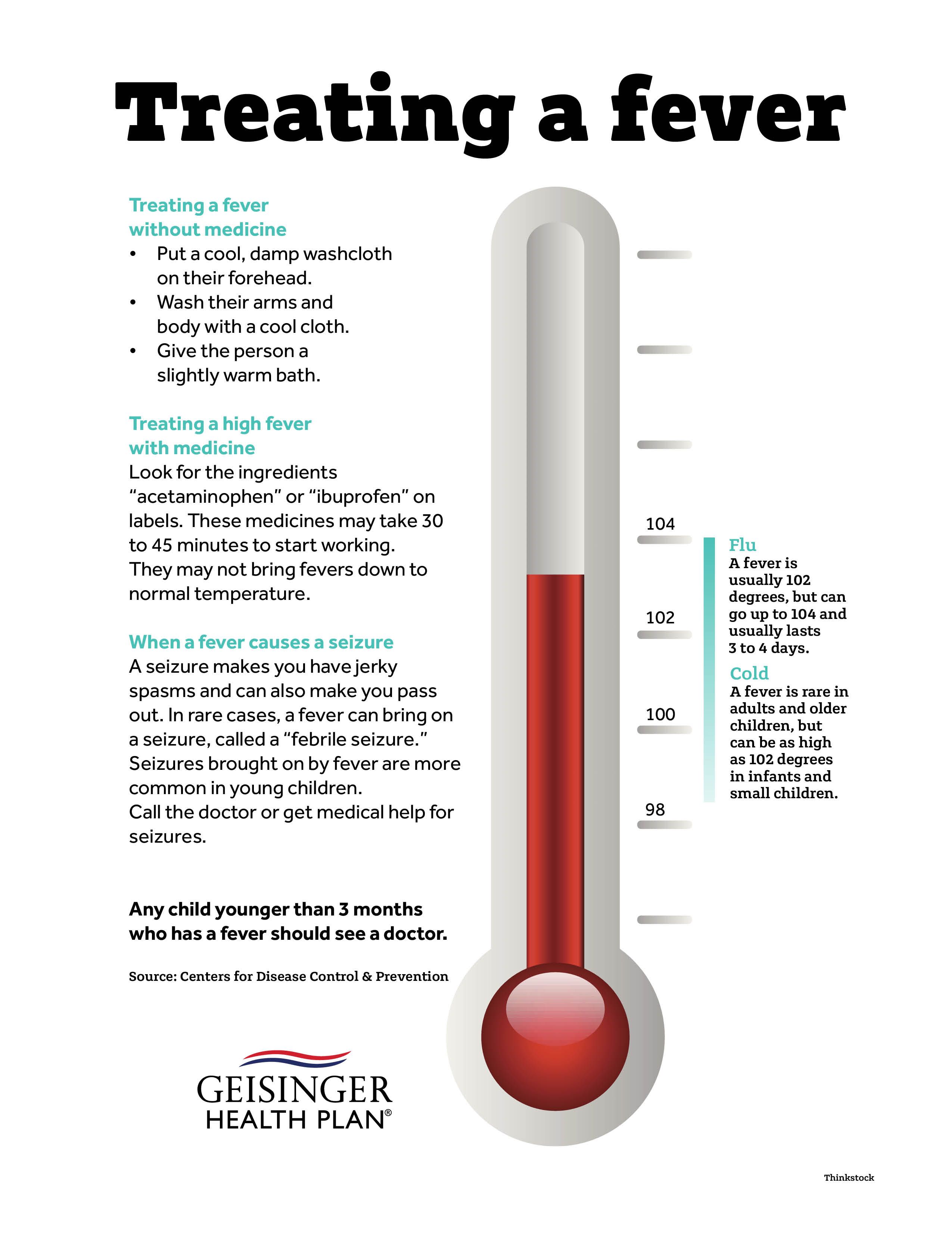
Infrared non-contact thermometers are convenient in that they show the temperature very quickly, besides, they can measure, for example, the temperature of water and everything else. But you must not forget to take care of them according to the instructions so that the readings are as accurate as possible.
Other thermometers (pacifiers, chemical, phone tips) are less reliable or less well understood.
8
If the temperature is high, what should I do?
It depends on your condition. If you feel unwell, take an antipyretic (such as ibuprofen or paracetamol) and drink enough fluids to stay hydrated. There are no magic numbers, after which you definitely need to bring down the temperature, no. Some harm directly from heat can only occur at very high values - 42 ° C and above.
It is true that a fever helps the immune system fight infection, but it cannot be said that there is reliable evidence. Another nuance directly related to the new coronavirus infection is the suspicion that ibuprofen worsens the course of the disease.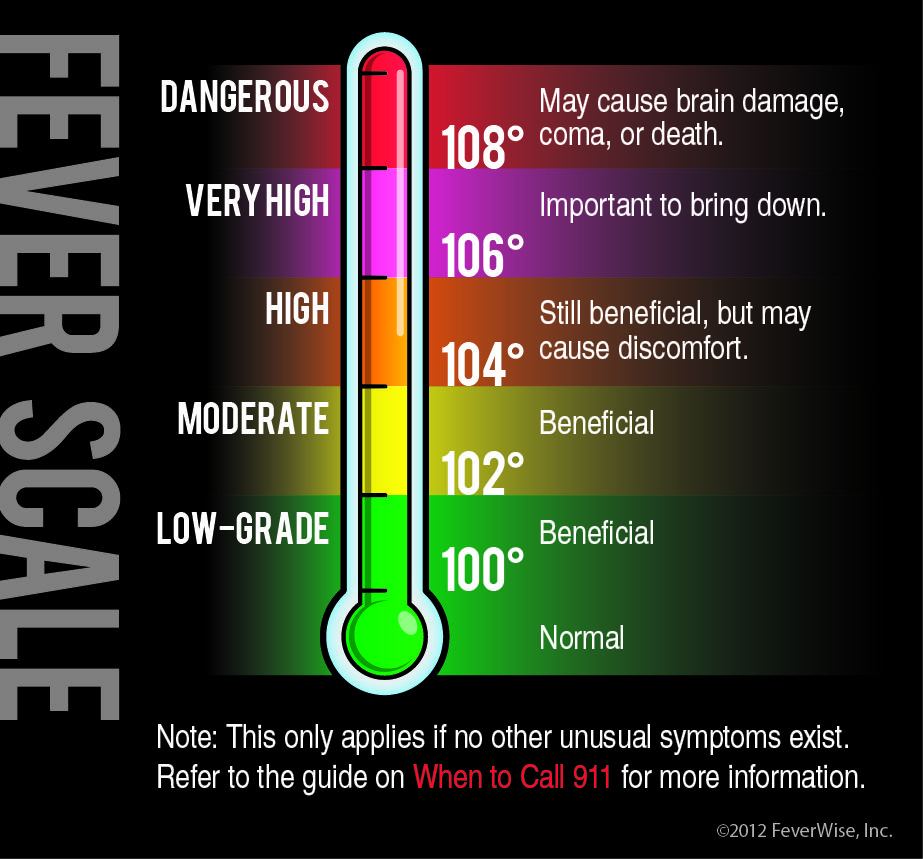

 4°F.
4°F.
 ) Temperatures in this range are common and don’t necessarily signal an emergency.
) Temperatures in this range are common and don’t necessarily signal an emergency. 2–104.0°F (39°C–40°C)
2–104.0°F (39°C–40°C)
